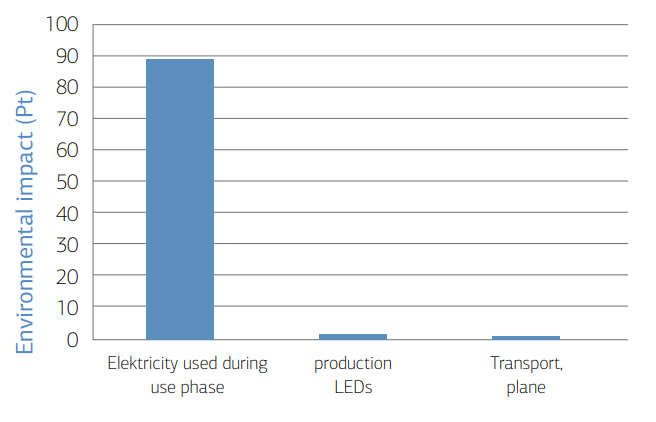Monitoring the impact of LED sign lighting systems
For UNETO-VNI, PRé conducted an LCA on the environmental performance of seven LED sign lighting systems. This helps them understand which performance indicators are important, and communicate to their member companies how to compare and improve their products.
About
LED lights are hailed as the future of lighting, including commercial signage. With their lower power consumption, longer lifespan, better durability and low heat output, LED lighting systems have many financial and environmental benefits over neon, incandescent and CFL commercial lighting systems. But are there large differences in environmental performance between different LED lighting systems? And what performance indicator is most important?
UNETO-VNI, a Dutch trade organization for contracting installing companies and technical retailers, provides its member companies with clear, useful information that helps them compare and improve their products. They approached PRé to help analyze the environmental performance and quality of currently available LED sign lighting systems, including long-term evaluation of environmental performance indicators.
Challenge
UNETO-VNI wanted to understand the differences in quality and environmental performance between different currently available LED sign lighting systems, so they could provide this information to their member companies. UNETO-VNI also wanted to monitor the performance of the seven selected LED sign lighting systems in a ‘real life’ situation for a period of five years, but did not know which environmental performance indicators to measure.
Solution
PRé first conducted a life cycle assessment (LCA) to evaluate the environmental performance of seven LED sign lighting systems. To do so, we created a questionnaire to gather information on the production of the LED systems and their transport to the Netherlands. Two suppliers provided us with data. Background data on the production of the components, such as printed wiring boards, cables and LEDs, came from the ecoinvent database. We used the collected information to model the products in the LCA software SimaPro. To calculate the total environmental impact, we applied the ReCiPe endpoint method, and to calculate the climate change impact, we applied the IPCC2007 method.
The baseline study shows that the largest environmental burden of a LED sign lighting system occurs as a result of the power it uses during the use phase of five years. As a result of this assessment, we determined a Key Environmental Performance Indicator (KEPI) for the monitoring phase which was energy use. The production phase of the LED systems had such a low impact that it was not investigated further. After completing the baseline study, we created a parameterized model so that results can be updated during the monitoring phase of five years.
The seven LED lighting systems were placed outside on a commercial building wall to start a five-year monitoring phase. This is the equivalent of 43,800 operating hours. The monitoring phase is intended to provide information about current energy use and quality loss of the LED systems, and will include reports of parts replacement.

Benefits
As a result of this study:
- UNETO- VNI now knows where to focus its data collection efforts.
- UNETO-VNI now knows the most important indicators for improvement and can communicate to its member companies which areas should be the focus of their improvement efforts.
- Manufacturers get the ability to compare their relative strengths and weaknesses to an industry average via benchmarking.
- Improved image for the industry as a whole by communicating the results of the study to a broad public through the UNETO-VNI website.
